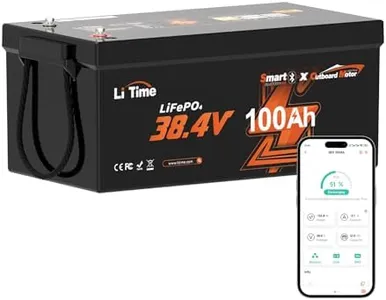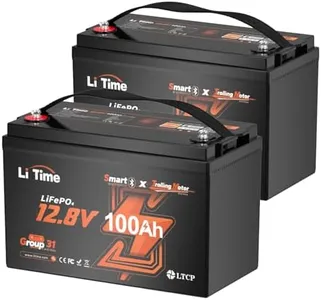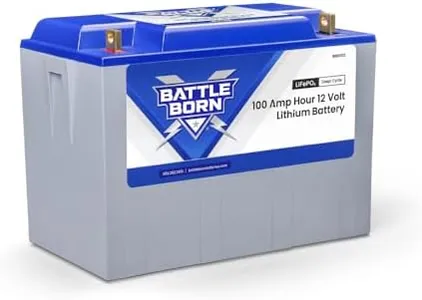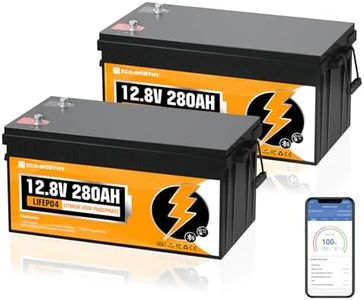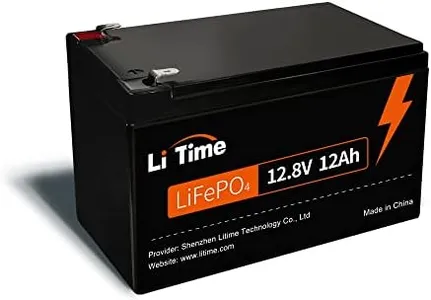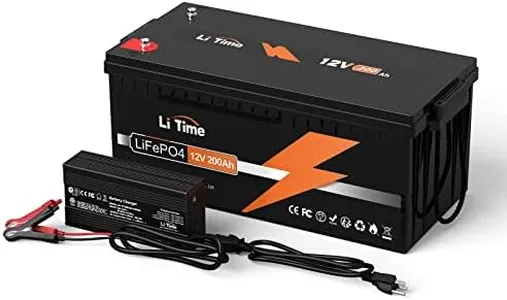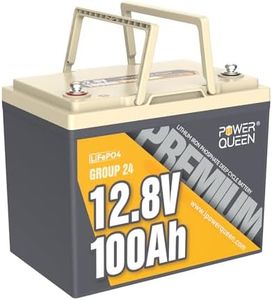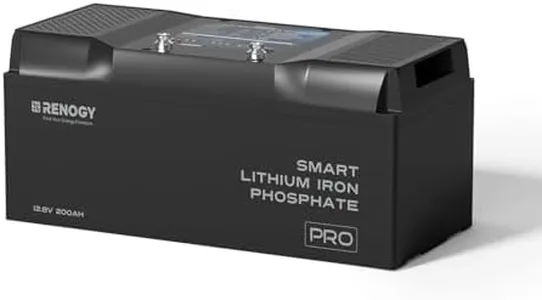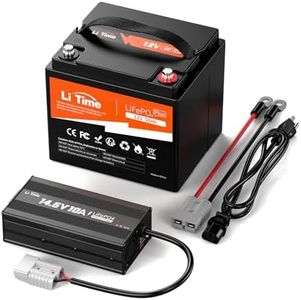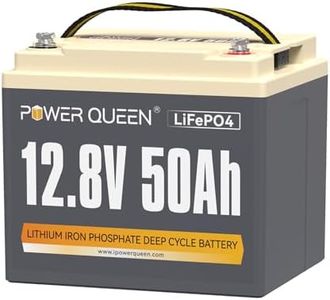Top 10 Lithium Battery For Kayak Deals Right Now
Litime
27%OFF
Editor’s Choice
Litime 12V 100Ah Trolling Motors LiFePO4 Battery (Group 31), 12 Volt Bluetooth Lithium Batteries, Max. 15000 Deep Cycles, 100A BMS, Low-Temp Protection for Marine, Boat, Yacht, RV, Solar (2-Pack)
Our technology thoroughly searches through the online shopping world, reviewing hundreds of sites. We then process and analyze this information, updating in real-time to bring you the latest top-rated products. This way, you always get the best and most current options available.

Our Top Picks
Litime 12V 100Ah Trolling Motors LiFePO4 Battery (Group 31), 12 Volt Bluetooth Lithium Batteries, Max. 15000 Deep Cycles, 100A BMS, Low-Temp Protection for Marine, Boat, Yacht, RV, Solar (2-Pack)
Most important from
309 reviews
The LiTime 12V 100Ah Lithium Iron Phosphate (LiFePO4) battery is well-suited for kayak trolling motors and other marine applications. Its 100Ah capacity and 12-volt output provide ample power for small to mid-sized electric motors, delivering about twice the energy range compared to typical lead-acid batteries. Weighing 22.2 lbs and fitting the standard Group 31 size, it’s lighter and more compact than many traditional batteries, helping keep your kayak agile and easier to handle on the water.
One standout feature is the triple protection Battery Management System (BMS), which guards against overcharge, overheating, short circuit, and even protects in harsh environments with dust, water, and salt spray resistance. It also includes a smart low-temperature cutoff to prevent damage if used in cold conditions. This makes the battery reliable and durable for outdoor marine use. The battery supports Bluetooth 5.0 connectivity, allowing you to monitor its status such as voltage and capacity in real time via a smartphone app, which is a useful touch for staying informed without guesswork.
The battery’s cycle life is impressive, rated for over 4000 deep discharge cycles, meaning it should last more than 10 years under typical use, a major upgrade over older battery technologies. Its charging speed depends on your charger, but it’s compatible with lithium-activation or MPPT chargers for efficient recharging. The battery can also be linked with others to build larger power systems if needed. While it’s lightweight compared to lead-acid batteries, 22 lbs is still somewhat hefty for small kayaks or if you plan frequent carry in and out. It is not intended for use as a starting battery or in golf carts, so it’s important to use it for trolling motors or similar continuous power needs only. Bluetooth activation requires an initial charge with a compatible charger, which might be a minor setup consideration. This battery offers a robust, long-lasting, and smart power solution for kayak trolling motors and other small marine craft, especially if you value durability, safety features, and real-time monitoring. It’s ideal for those wanting a lightweight, efficient, and weather-resistant battery but may be a bit heavy for ultra-light kayak setups.
Most important from
309 reviews
Great Choice
LiTime 36V 50Ah Trolling Motor Bluetooth Low-Temp Protection LiFePO4 Battery Buit in 50A BMS, Deep Cycle Group31 Lithium Iron Phosphate Battery Perfect for Trolling Motors, Marine, Boat, Home Energy
Most important from
46 reviews
The LiTime 36V 50Ah TM Bluetooth Low-Temp Protection LiFePO4 Battery is a robust and reliable choice for those needing a high-performance lithium battery for their kayaks, particularly for trolling motors. One of its standout features is the Bluetooth 5.0 integration, which allows users to monitor battery status in real-time, offering convenience and ease of use. This is particularly beneficial for long trips where keeping an eye on the battery’s health is crucial. It also boasts a long cycle life of over 4000 cycles, significantly surpassing traditional lead-acid batteries, which typically last for only 200-500 cycles. This translates to a longer lifespan and better value over time.
Additionally, the battery is designed to withstand harsh marine environments, with protections against humidity, salt spray, and various electrical hazards. This makes it a durable choice for outdoor and marine applications. The option to expand capacity by connecting up to four batteries in parallel is another strong point, providing flexibility for users needing more power.
However, the battery is relatively heavy at 33.14 lbs, which could be a consideration for those looking to minimize weight on their kayaks. Additionally, while the battery offers robust features, the initial setup requires the use of a specific charger to activate the Bluetooth function, which might be a bit inconvenient for some users. This battery is highly suitable for kayaks and other marine uses, offering reliability, advanced monitoring features, and a long lifespan, though its weight and initial setup requirements might be minor drawbacks for some users.
Most important from
46 reviews
100Ah 12V Lithium-Ion (LiFePO4) RV, Marine, Solar, & Off Grid Battery - Internal BMS, High & Low Temperature Protection - Battle Born Batteries
Most important from
860 reviews
The Battle Born 100Ah 12V Lithium-Ion Battery stands out primarily due to its impressive capacity and versatility, making it a great choice for kayak enthusiasts looking for a reliable power source. With a 100Ah capacity, it offers substantial power, ensuring long-lasting performance on the water. Its 12V voltage is standard for most kayak needs, providing compatibility with various electrical systems. Weighing only 31 pounds, it is quite lightweight for its size, which is beneficial for maintaining the balance and maneuverability of a kayak without adding unnecessary weight.
In terms of durability, this battery boasts a considerable cycle life, with 3,000-5,000 deep discharge cycles, promising a lifespan of up to 10-15 years. This makes it a cost-effective investment, as it requires less frequent replacements compared to traditional lead-acid batteries. Its internal Battery Management System (BMS) adds an extra layer of safety, offering protection against low temperatures, high and low voltage, and short circuits, crucial for outdoor and marine environments.
The battery's design as a drop-in replacement for Group 27 and 31 batteries adds convenience, and its ability to be wired in series or parallel gives users flexibility in customizing their power setup. However, while the battery is described as rugged and suitable for marine use, the specific details regarding its water resistance are not explicitly mentioned, which might be a consideration for users expecting heavy water exposure. If safety, longevity, and power efficiency are priorities, especially for those using multiple electronic devices on their kayak, this battery offers significant advantages. Potential buyers should ensure their specific water resistance needs are met either by this battery or through additional protective measures.
